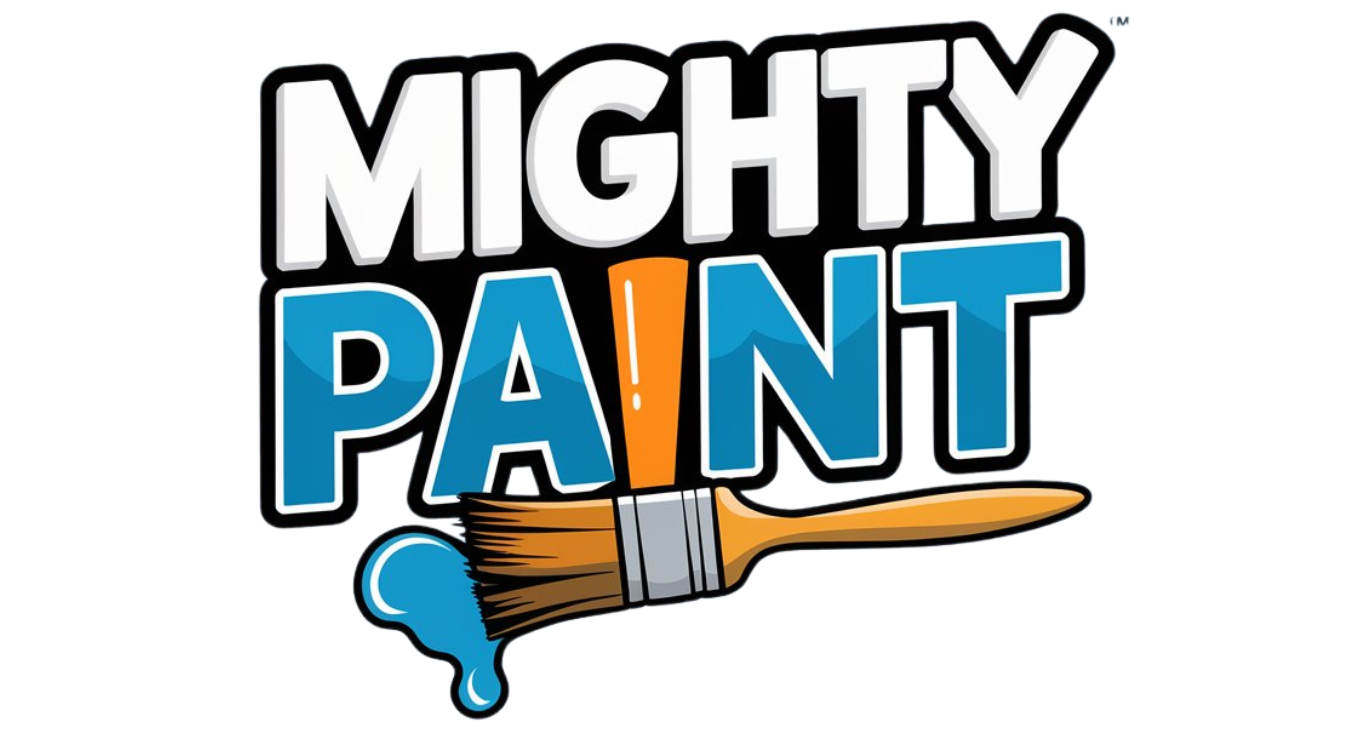25 Stunning Wood Floor Design Ideas That Instantly Elevate Any Space
Wood flooring has long been a staple of stylish and enduring home design. Its natural beauty, warmth, and durability have made it a top choice for homeowners across generations. But while the material remains timeless, the ways we use and design with it have evolved dramatically. Today’s wood floors are not just surfaces to walk on—they’re foundational elements that define the personality and flow of a space.
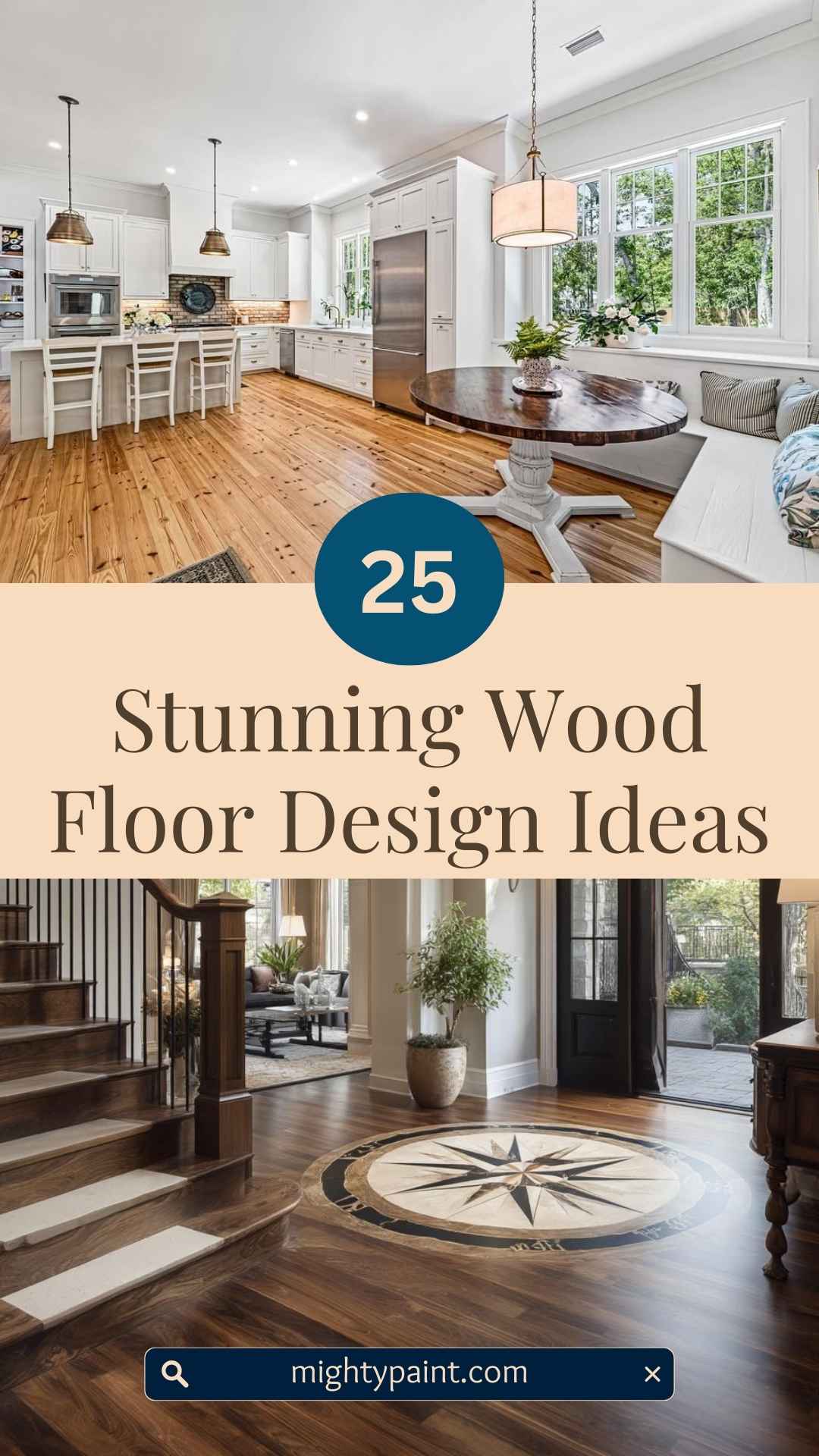
Modern design trends are pushing the boundaries of traditional wood flooring with creative layouts, bold finishes, eco-conscious materials, and innovative technology. From intricate parquet patterns to sustainable reclaimed wood and smart floors with built-in sensors, the possibilities are more exciting than ever. Whether you prefer a classic aesthetic or lean toward cutting-edge contemporary design, there’s a wood floor idea that can elevate your interior.
Get the Fail-Safe Paint Color Playbook (Free PDF)
36 proven colors • 8 ready palettes • trim & sheen guide • printable testing cards.
In this article, we’ll explore 25 inspiring wood floor design ideas that go beyond the basics. Whether you’re planning a new build or updating your existing home, these trends and techniques will help you make a statement from the ground up.
Classic Patterns with a Modern Twist
Traditional wood flooring patterns have stood the test of time, but modern interpretations bring fresh flair to these age-old designs. These patterns not only offer visual interest but can also guide the flow of a room and influence how large or dynamic it feels. Today’s homeowners are rediscovering these layouts—often with updated finishes, materials, and applications—to infuse character and elegance into their floors.
1. Herringbone Elegance
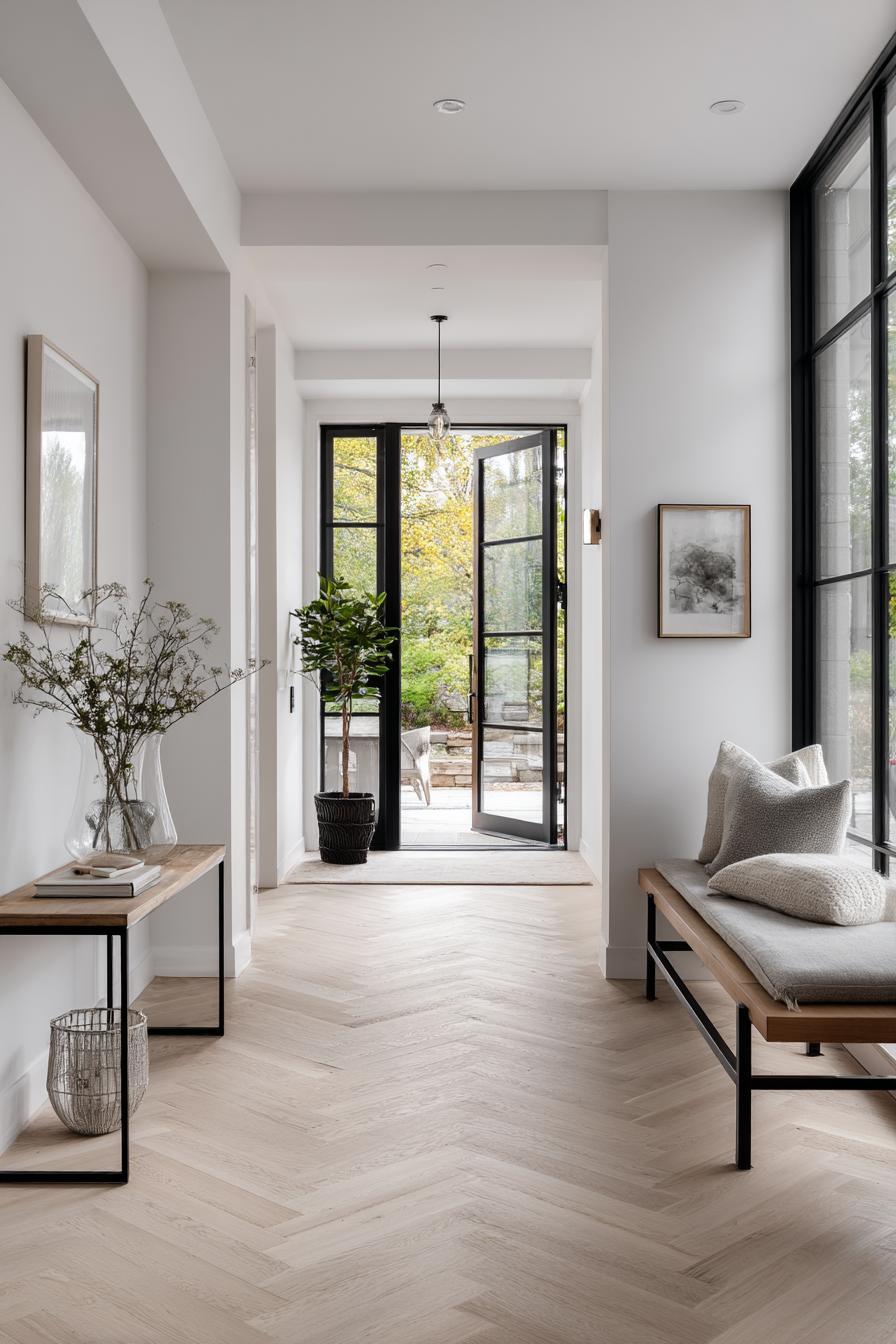
The herringbone pattern, with its distinctive “V” shaped arrangement, has roots in European architecture dating back centuries. It remains a design favorite today due to its structured rhythm and classic appeal. In this pattern, rectangular planks are laid at right angles to each other, forming a zigzag that draws the eye along its lines.
Modern adaptations of herringbone flooring often involve wider planks, neutral stains, or wire-brushed finishes that give the floor a subtle texture. These updates make the style suitable for both traditional and contemporary homes. Herringbone works beautifully in entryways and long hallways, where the directional pattern helps elongate the space. It’s also a clever way to bring movement into otherwise static, rectangular rooms.
To enhance its modern appeal, many designers recommend pairing herringbone with minimalist decor and neutral palettes, allowing the floor itself to serve as a design centerpiece. Whether in rich walnut or pale white oak, herringbone remains timeless, yet totally in vogue.
2. Chevron Sophistication
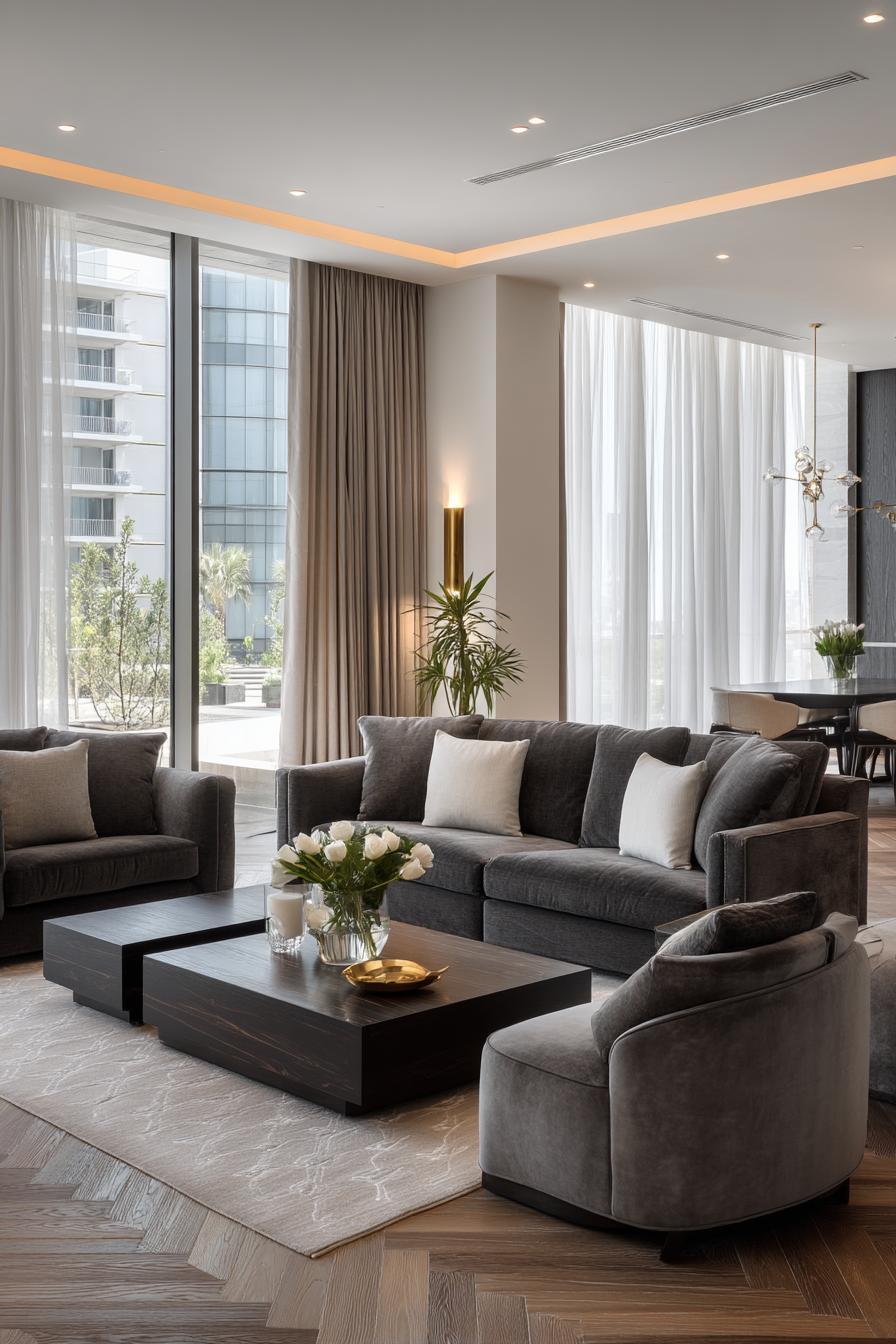
Often confused with herringbone, the chevron pattern differs in one important detail: the ends of the planks are cut at an angle, creating a continuous zigzag without the broken edges found in herringbone. This seamless flow gives chevron a sleek, modern aesthetic while still nodding to its historic elegance.
Chevron flooring adds a dynamic sense of movement and can visually widen or lengthen a room depending on the direction of the planks. It’s a striking choice for open-plan living areas, formal dining rooms, or chic bedrooms where bold design is welcome. Designers often opt for light-stained woods like ash or maple to modernize the look, though deeper tones can offer a dramatic, Parisian flair.
Installing chevron flooring requires precision, which can elevate the sense of craftsmanship and luxury in a space. Combined with clean-lined furniture and strategic lighting, chevron delivers sophistication and architectural interest in one fluid pattern.
3. Basket Weave Charm
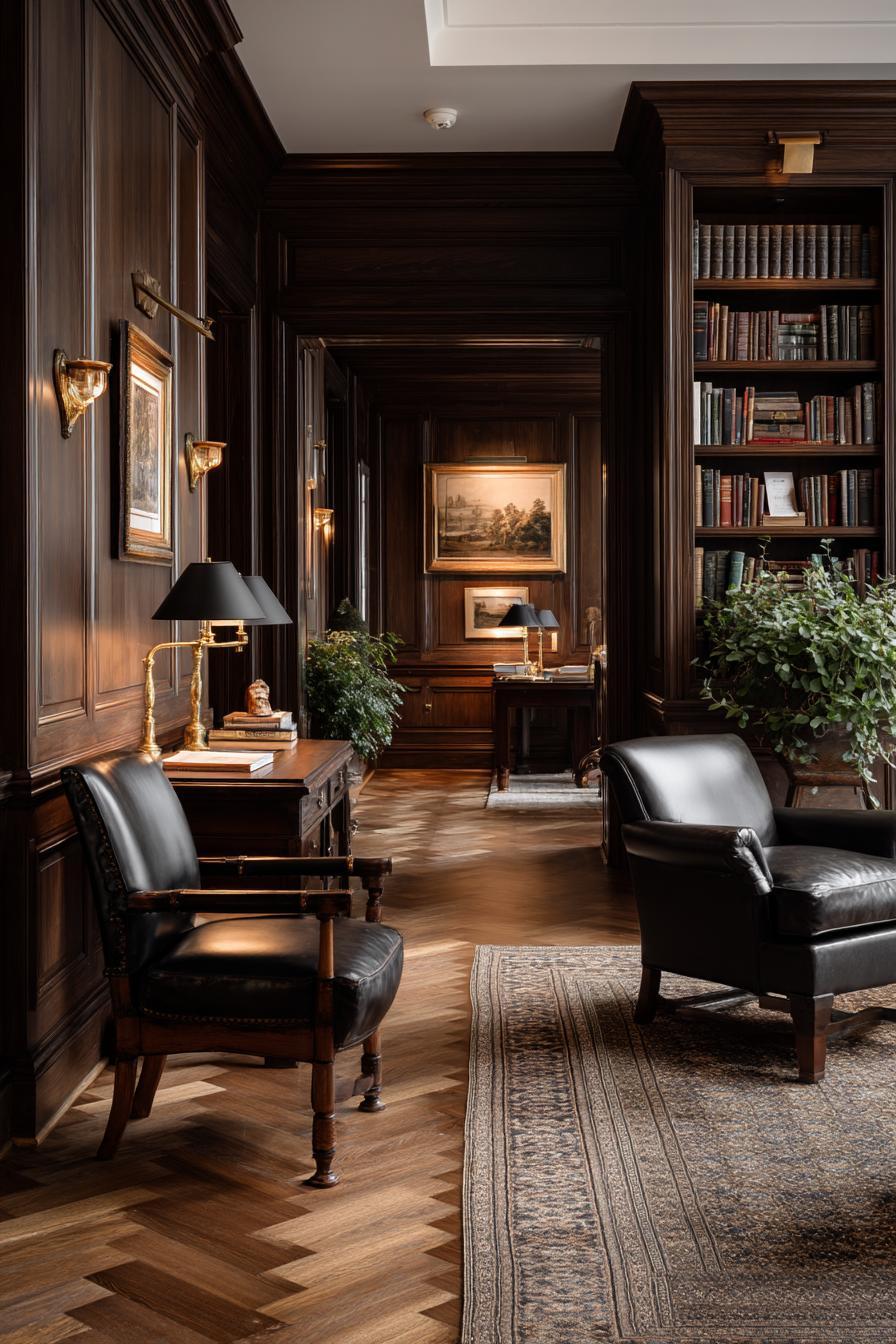
The basket weave pattern adds textural intrigue and vintage charm to any room. As the name suggests, it mimics the look of woven fabric, typically formed by alternating pairs or trios of short wood planks laid horizontally and vertically. This intricate arrangement creates small square units that repeat across the floor, adding layers of depth and complexity.
Ideal for traditional interiors, historic homes, or rooms needing a touch of classic charm, basket weave flooring can be made more contemporary by using lighter woods, matte finishes, or larger plank groupings. It’s often seen in high-end foyers, libraries, or formal sitting rooms, where its detailed design is on full display.
To ensure balance in a space with basket weave flooring, it’s best to pair it with simpler furnishings and streamlined décor. This pattern does much of the visual work, allowing homeowners to keep the rest of the design understated yet elegant.
4. Parquet de Versailles
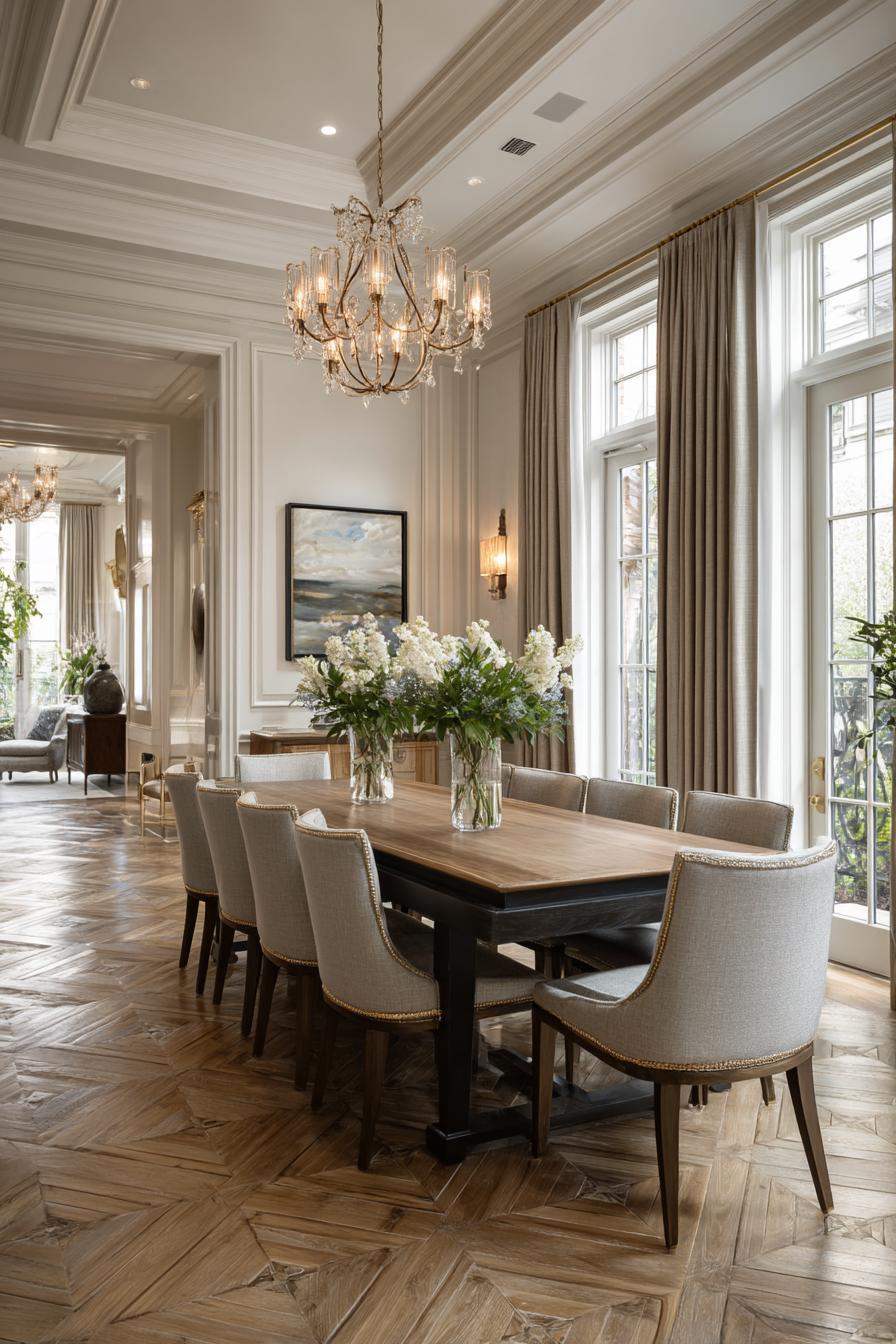
The Parquet de Versailles pattern is the epitome of luxury and old-world craftsmanship. Originating in 17th-century France, this intricate design was first used in the Palace of Versailles, hence its name. The pattern consists of square panels filled with diagonally placed small wood slats that intersect in a decorative, geometric motif, often framed with borders. It’s an opulent style that immediately signals sophistication and heritage.
Modern versions of Parquet de Versailles have made their way into contemporary homes with simplified details and neutral finishes that make the ornate pattern more adaptable. Rather than being reserved solely for formal salons and dining rooms, it is now used in upscale kitchens, luxury lofts, and even boutique hotel-inspired bedrooms. Oak is a common wood choice for this pattern, especially when finished with a matte sealant to tone down its formality while preserving its artistic edge.
Get the Fail-Safe Paint Color Playbook (Free PDF)
36 proven colors • 8 ready palettes • trim & sheen guide • printable testing cards.
Though installation is complex and best handled by seasoned professionals, the result is nothing short of breathtaking. For homeowners who want their flooring to double as art, Parquet de Versailles is a showstopper that never goes out of style.
Innovative Layouts and Materials
As wood flooring continues to evolve, so do the creative ways in which it’s installed. Designers and homeowners alike are pushing the boundaries with unconventional layouts and mixed materials that offer a fresh perspective on what a floor can be. These innovative ideas aren’t just about aesthetics—they also solve spatial challenges, define areas in open-concept spaces, and add a unique personal touch to interiors.
5. Mixed Width Planks

Using planks of varying widths is a subtle but effective way to add depth and a custom feel to wood floors. Rather than sticking to uniform sizes, mixed-width floors incorporate two or three different widths in a repeating or random pattern. This creates a more organic, natural look that reflects the irregularities found in traditional, hand-hewn wood planks.
This technique is especially popular in rustic, farmhouse, and transitional interiors, but it can be tailored to modern designs as well by using cool-toned woods or engineered products with sleek finishes. Mixed width floors also work well in large rooms, where the variation in plank size adds scale and breaks visual monotony.
In addition to visual interest, mixed widths can also be cost-effective, allowing installers to use remnants or bundles of wood more efficiently. Whether finished in a natural oak, a smoky gray, or a dark espresso, this layout exudes handcrafted charm with a contemporary twist.
6. Diagonal Installations
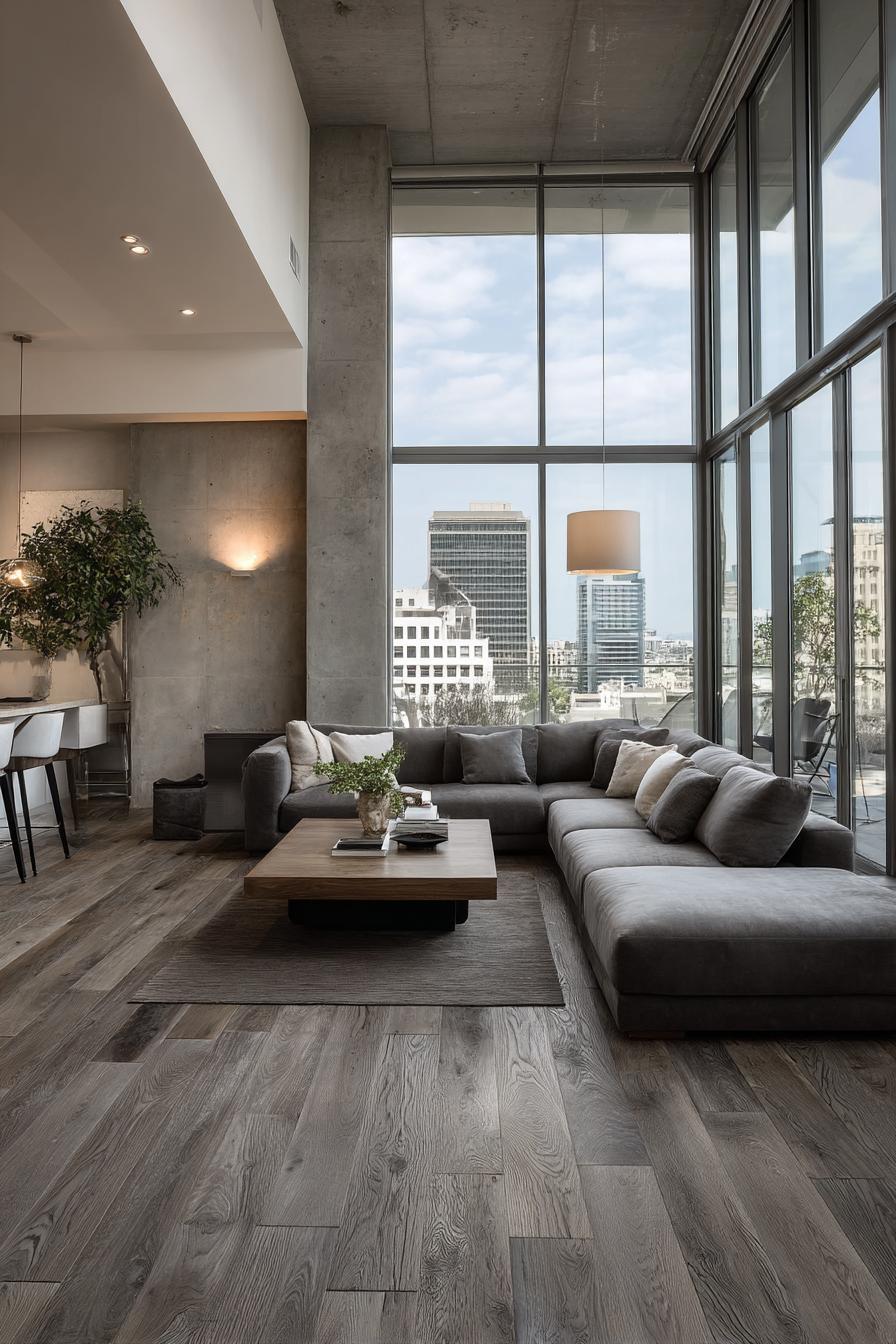
Laying wood planks diagonally across a room is a bold move that pays off in both style and spatial impact. Unlike traditional parallel installations, diagonal layouts run at a 45-degree angle to the walls, creating visual energy and a greater sense of movement. This technique can make narrow or small rooms appear larger by breaking up the linear monotony and drawing the eye across the full expanse of the floor.
Diagonal flooring works well in a variety of interior styles, from classic to modern, depending on the wood type and finish used. Light woods in matte finishes offer a casual, beachy vibe, while darker, high-gloss planks bring a more formal, dramatic flair. It’s also an effective way to unify an open-concept floor plan, as the diagonal lines flow naturally from one space to another.
While diagonal installation may require more planning and material waste than standard layouts, the aesthetic payoff is substantial. It’s a simple twist on tradition that gives the entire room a more dynamic and customized appearance.
7. Wood and Tile Combinations
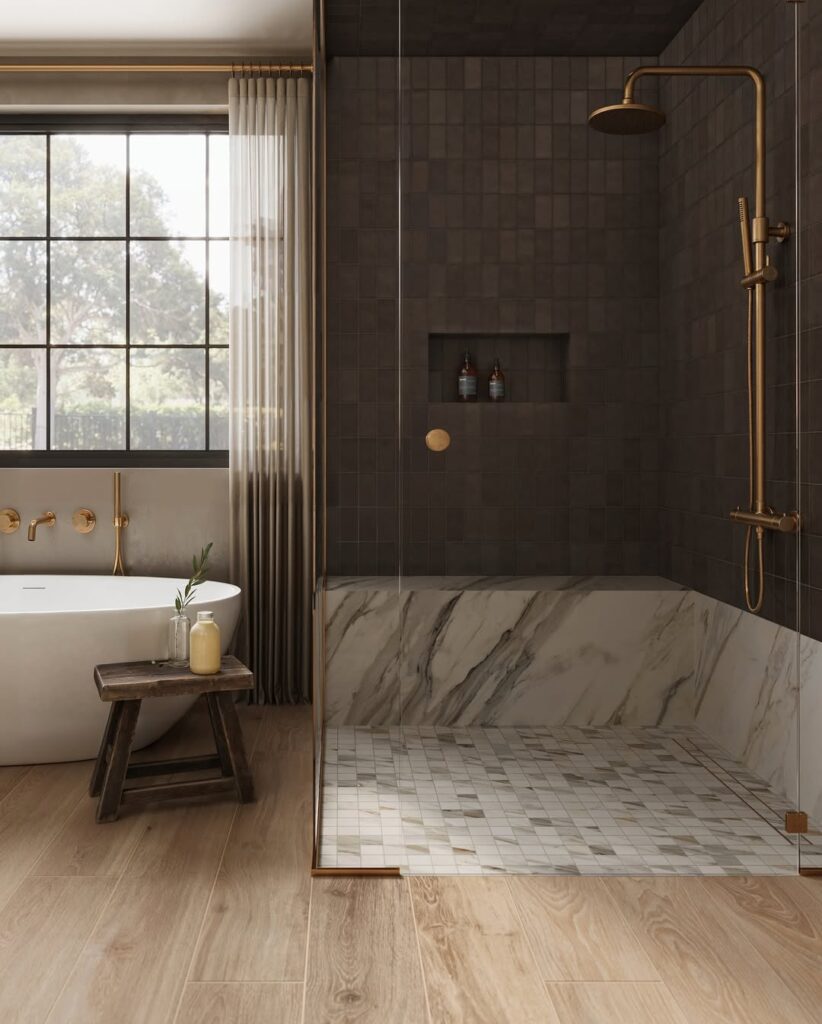
Mixing wood and tile within the same floor design creates striking visual transitions and offers a practical solution for multi-functional spaces. This trend is especially popular in open-plan kitchens and dining areas, where the durability of tile meets the warmth of wood. Designers often use patterned tile “rugs” framed by wood borders, or transition the two materials in organic, interlocking shapes like hexagons or waves.
This blend of textures and materials allows for creative zoning in a space without the need for walls or dividers. It’s ideal for homes with eclectic or boho-chic styles, but also adaptable to modern and industrial aesthetics depending on the colors and materials used.
The key to making wood and tile combinations work is seamless execution. Matching heights, finishes, and expansion gaps ensures that the transition looks intentional and polished. Done well, this technique turns the floor into a statement piece that balances form and function beautifully.
Get the Fail-Safe Paint Color Playbook (Free PDF)
36 proven colors • 8 ready palettes • trim & sheen guide • printable testing cards.
8. Inlaid Borders and Medallions
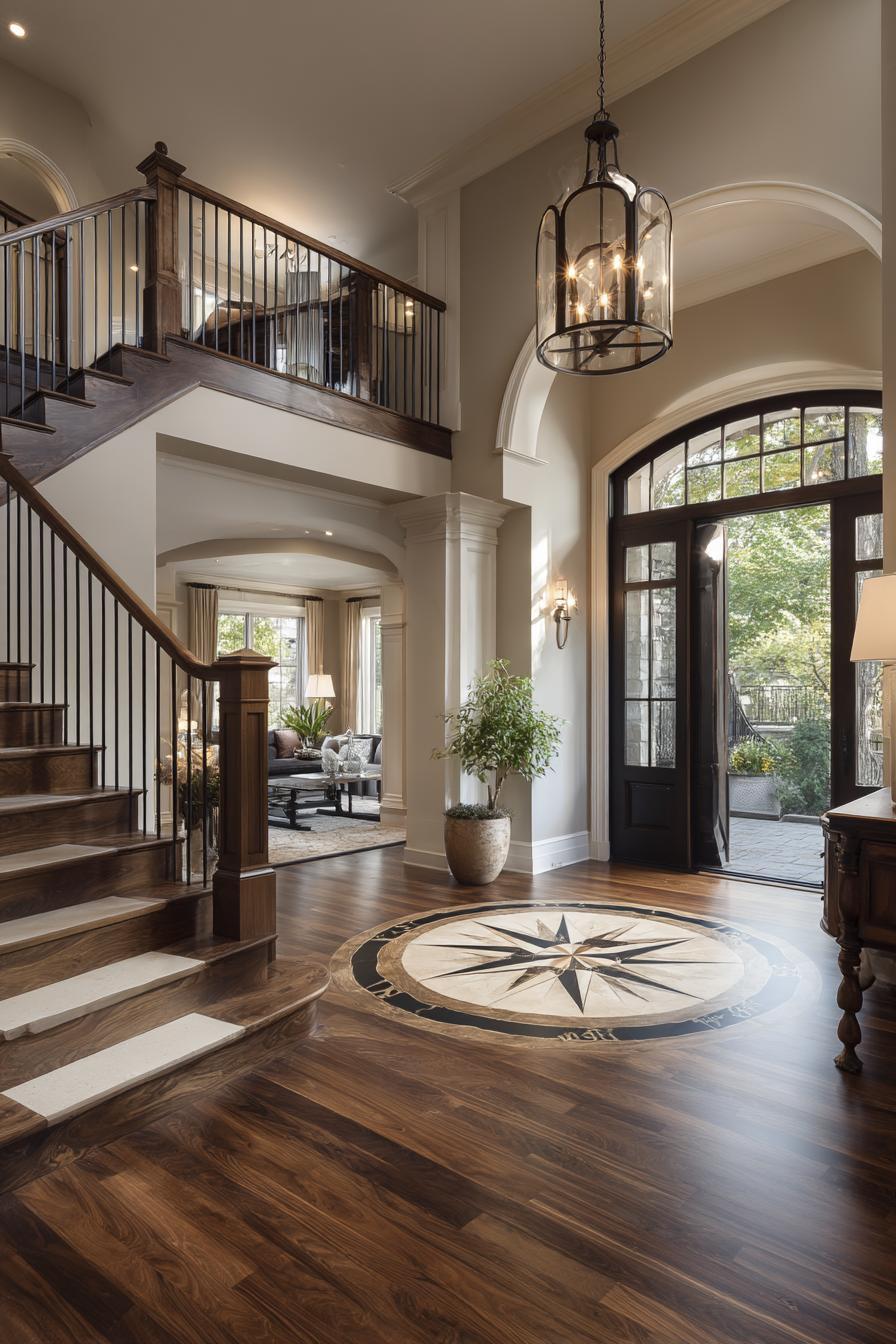
Inlays offer a refined way to personalize wood flooring with decorative detail. Borders—thin strips of contrasting wood running around the perimeter of a room—can frame a space, highlight architectural features, or distinguish between adjoining areas. Medallions, often placed at the center of a foyer or under a chandelier, act as visual focal points and can be intricately designed with floral, geometric, or compass rose patterns.
These elements add old-world elegance to a floor, evoking the craftsmanship of antique homes and historic estates. But today’s inlays can also be modern and minimalist, using subtle wood grain contrasts or geometric simplicity to fit contemporary interiors.
Advanced laser-cutting and CNC technology have made it easier to produce complex inlays with precision. Whether made from exotic woods, metals, or even mother-of-pearl, these accents turn standard wood floors into works of art and offer an extra layer of personalization to your home’s interior design.
Color and Finish Innovations
While the layout of wood flooring plays a major role in interior design, color and finish are just as transformative. Advances in staining and sealing techniques now offer a wider palette of tones and sheens than ever before. From cool grays to sun-bleached whites and high-gloss varnishes, these innovative treatments allow homeowners to customize their flooring to reflect their personal style, lighting conditions, and overall decor theme.
9. Gray-Washed Finishes
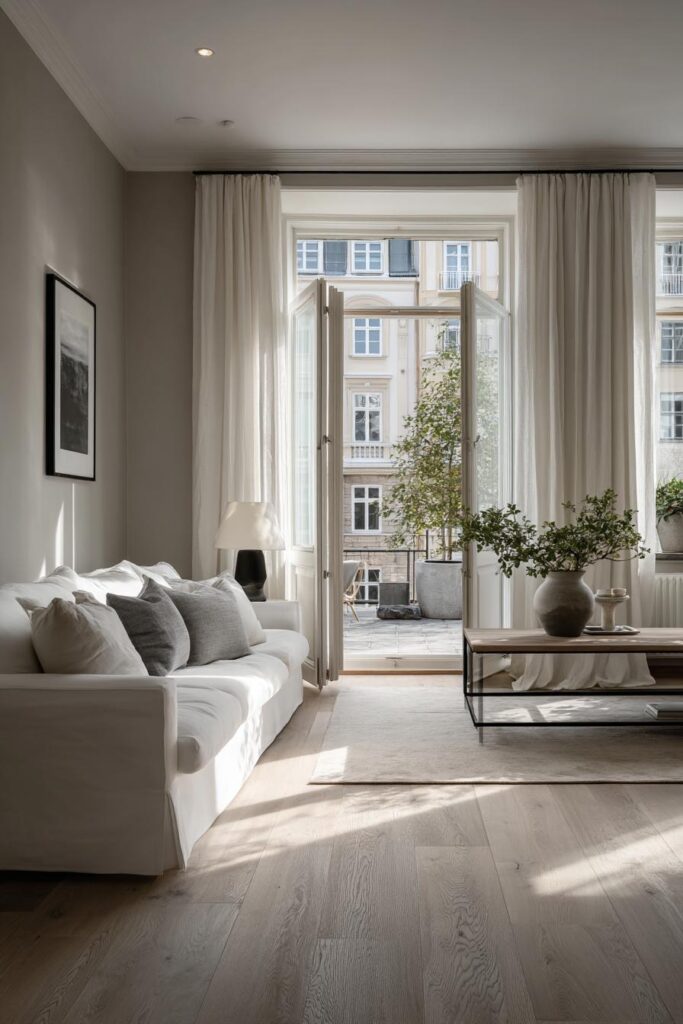
Gray-washed wood floors have emerged as a leading trend in contemporary interiors, offering a sophisticated alternative to traditional brown or red-toned wood. These finishes range from soft dove gray to deeper charcoal tones, often applied through a combination of light staining and whitewashing techniques that mute the wood’s natural color while enhancing its grain.
Gray floors work beautifully in modern, industrial, or Scandinavian-style homes, complementing everything from white walls to black metal accents and cool-toned furnishings. They’re particularly effective in bright, sunlit rooms where the cool undertones prevent yellowing or over-warmth. Lighter gray-washed woods create an airy, expansive feel—ideal for small or minimalist spaces—while darker grays add depth and drama.
Additionally, gray-washed floors hide dust and scratches better than some darker or glossy alternatives, making them both stylish and practical. Whether applied to oak, maple, or engineered wood, this finish is a versatile and contemporary option that lends a calm, curated look to any room.
10. Whitewashed and Bleached Woods
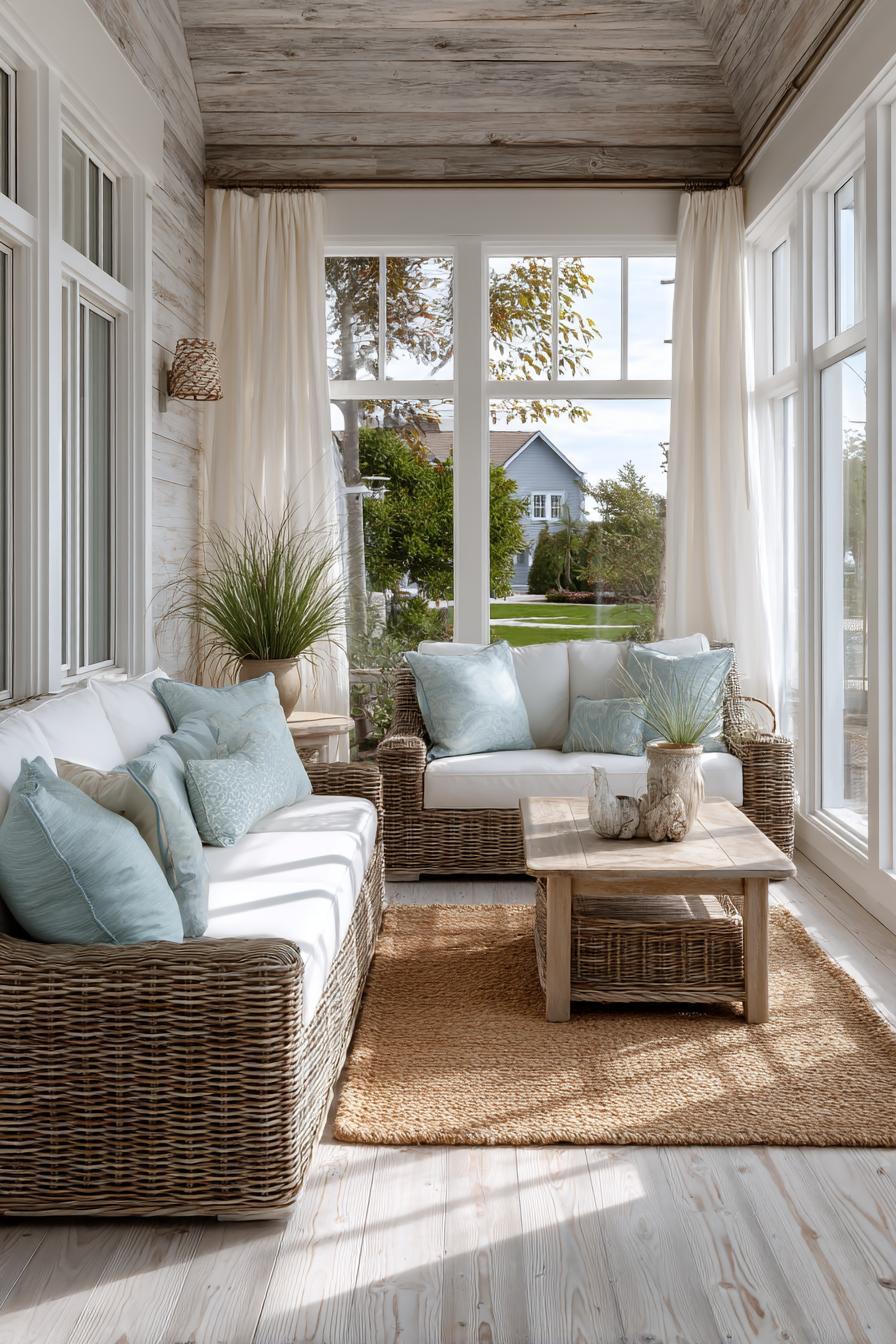
Whitewashed and bleached wood finishes offer a fresh, coastal vibe that brings lightness and brightness into a home. This look, which softens the natural tones of the wood without fully covering the grain, is especially popular in beach houses, Scandinavian-inspired interiors, and rustic farmhouse designs. The result is a floor that feels clean, airy, and relaxed.
The whitewashing process typically involves a diluted white stain or pigment that is wiped or brushed into the surface, then sealed for durability. Bleaching, on the other hand, chemically lightens the wood’s natural pigment, creating a more neutral canvas for additional color treatments. Both methods emphasize texture and natural imperfections, celebrating the organic character of wood.
Get the Fail-Safe Paint Color Playbook (Free PDF)
36 proven colors • 8 ready palettes • trim & sheen guide • printable testing cards.
These finishes pair well with soft neutrals, pastel tones, and raw materials like linen, stone, and jute. They’re also ideal for making small rooms feel larger and more open. For an effortlessly elegant aesthetic, whitewashed and bleached woods are a timeless and low-key luxurious choice.
11. Dark and Moody Tones
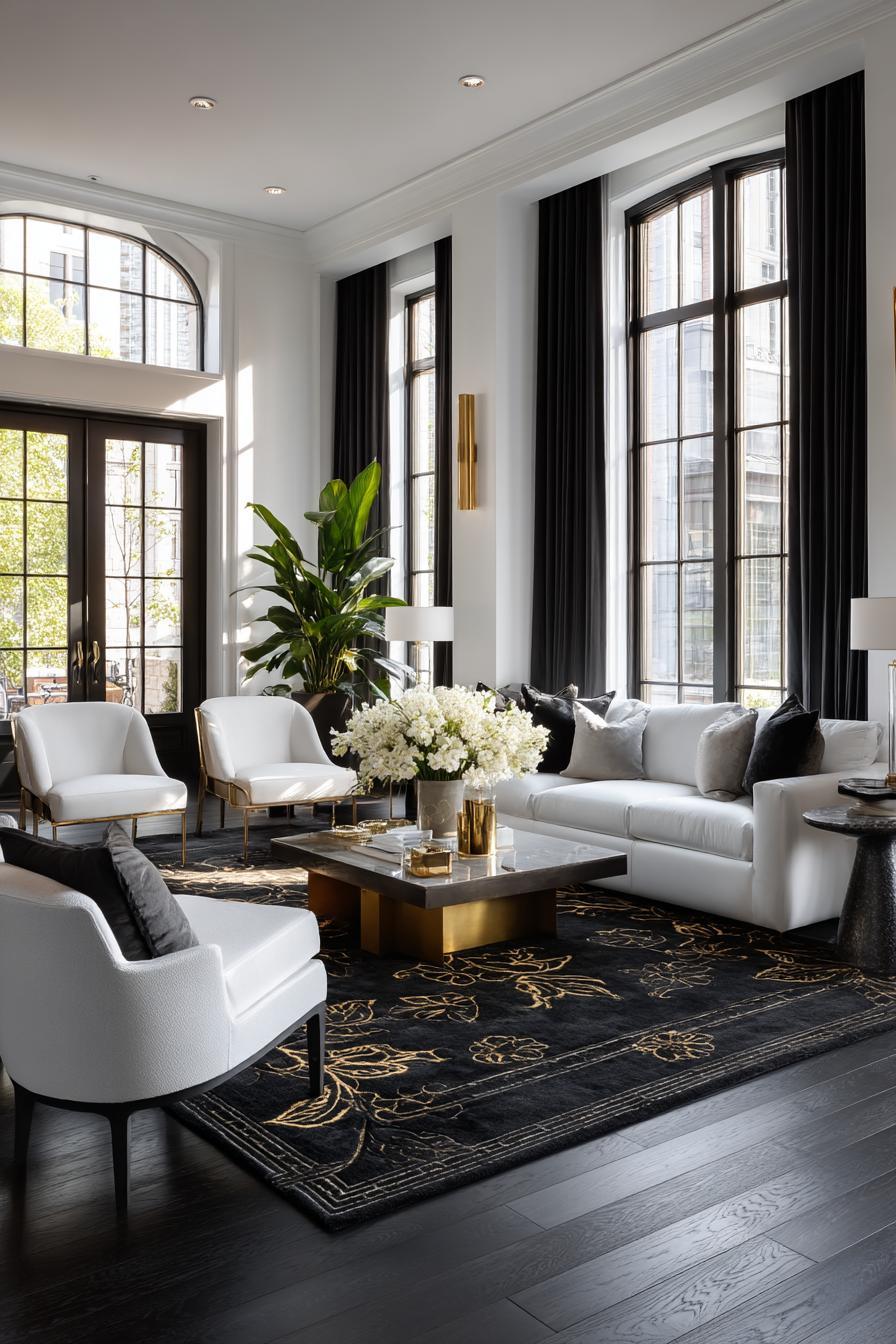
For those who prefer a bold, dramatic aesthetic, dark wood floors in tones like espresso, ebony, or deep walnut deliver instant impact. These rich stains create a luxurious foundation that contrasts beautifully with lighter walls and bright décor. They bring depth and coziness to larger rooms and work exceptionally well in traditional, contemporary, and modern classic designs.
Dark floors can highlight architectural features, ground a space with visual weight, and make a statement of elegance and formality. They pair especially well with high ceilings, oversized windows, and open layouts that provide plenty of natural light to balance the darker tones.
However, dark finishes can show dust, scratches, and pet hair more easily than lighter shades. Choosing a wood species with a strong grain—like oak—or using a satin or matte finish can help mitigate this. When cared for properly, dark and moody wood floors exude a richness and timeless charm that few other finishes can match.
12. High-Gloss Finishes
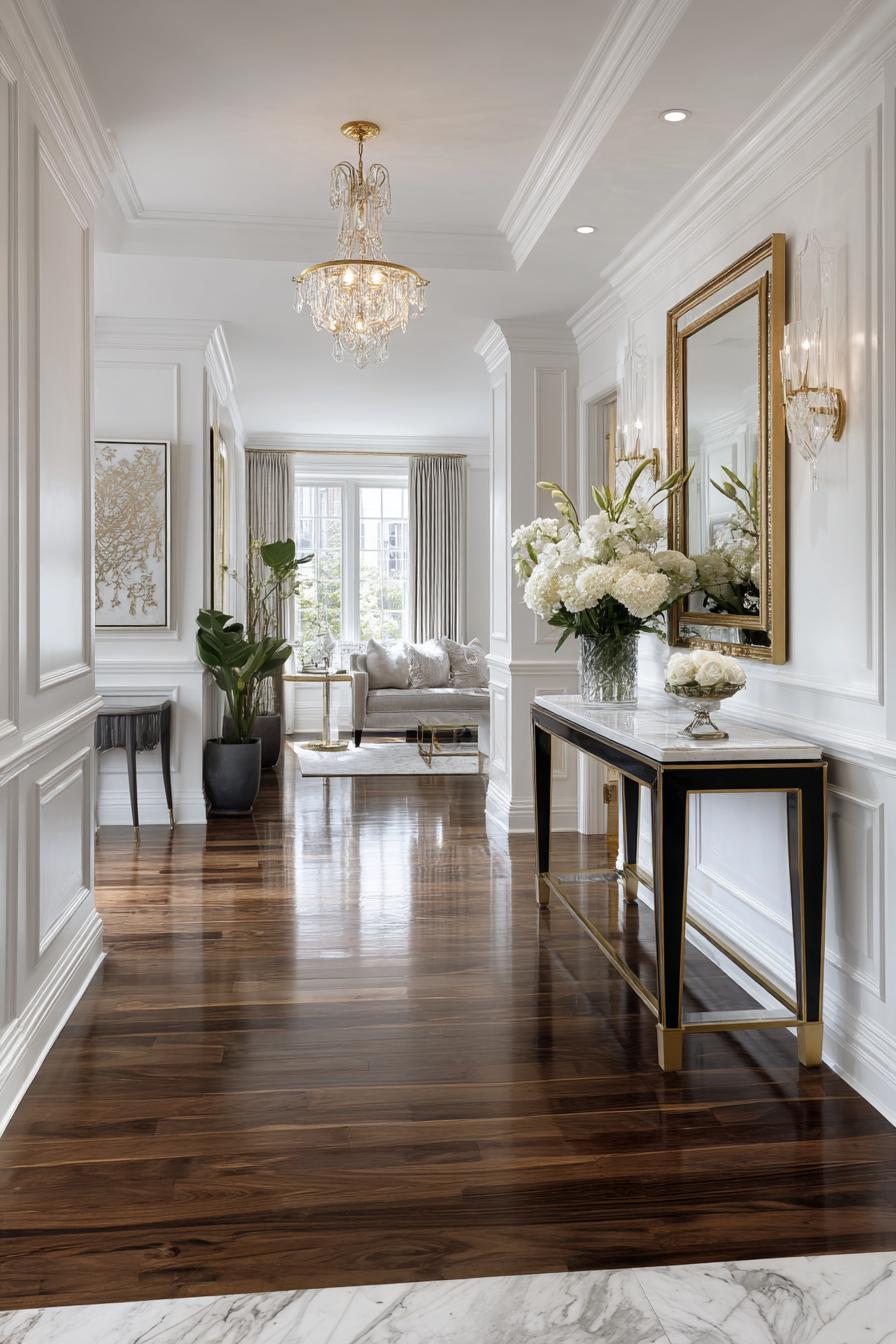
High-gloss wood flooring offers a sleek, reflective surface that instantly elevates any room with a polished, high-end appearance. This finish enhances the natural color and grain of the wood, making it a great choice for showcasing premium hardwood species like mahogany, walnut, or cherry. Its mirror-like sheen reflects light, which can help smaller or darker rooms feel more expansive and luminous.
While often associated with formal or modern interiors, high-gloss floors can be adapted for contemporary and even glam styles when paired with metallics, glass, and luxe textiles. They’re particularly stunning in entryways, dining rooms, or living areas where visual drama is welcome.
However, this finish does come with maintenance considerations. It tends to highlight dust, footprints, and scratches more than matte or satin alternatives, making it less ideal for high-traffic or pet-friendly homes. That said, with proper care and strategic use in lower-traffic areas, high-gloss floors can add an unmatched level of sophistication and brightness to any interior.
Sustainable and Eco-Friendly Options
With growing awareness around environmental impact and health-conscious living, many homeowners are choosing sustainable wood flooring options. From reclaimed timber with storied pasts to rapidly renewable materials like bamboo and cork, eco-friendly floors now offer just as much style and durability as traditional hardwoods—often with the added benefit of a smaller carbon footprint.
13. Reclaimed Wood Flooring
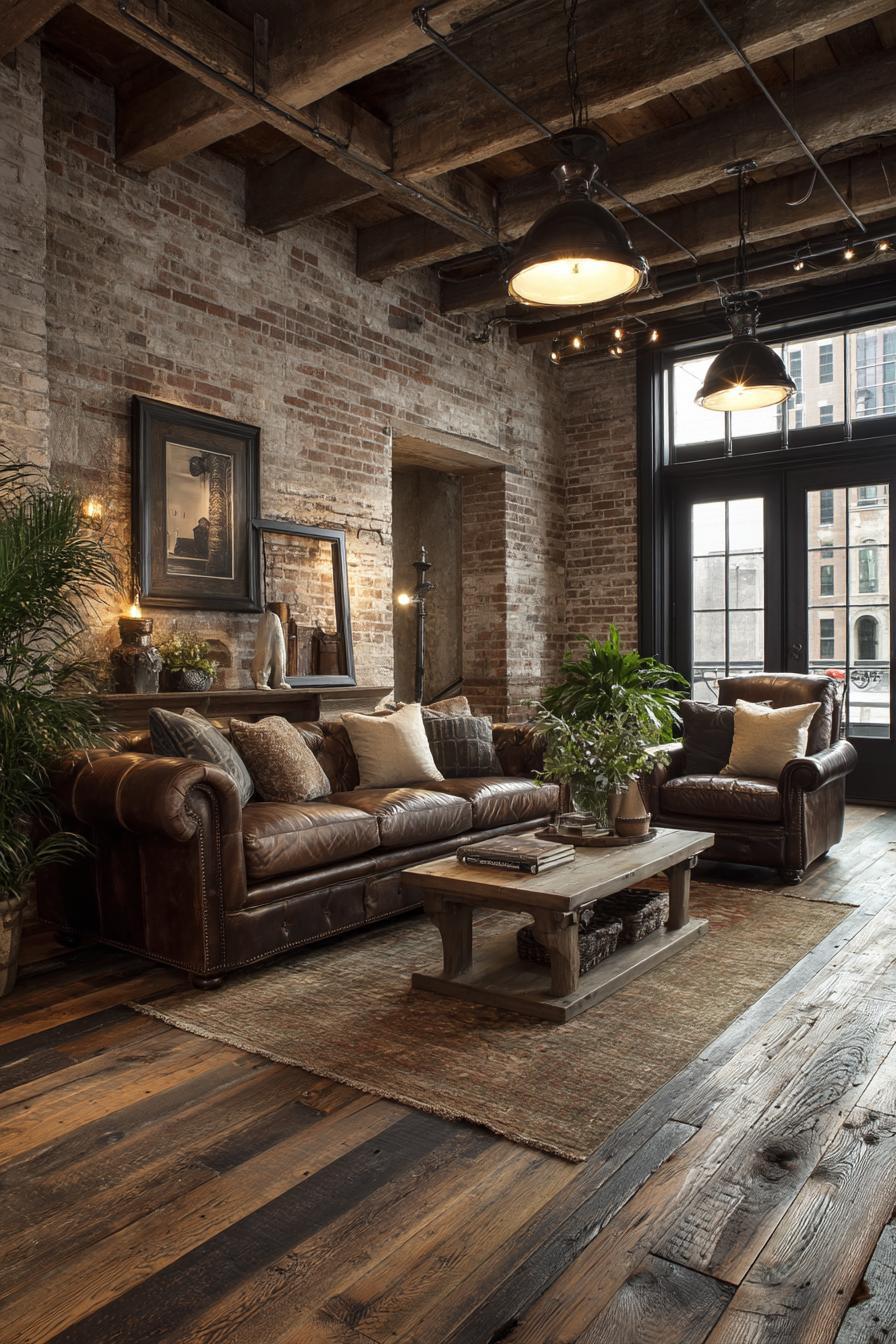
Reclaimed wood flooring is a sustainable and character-rich choice that gives old materials new life. Sourced from barns, factories, and other historical structures, this wood often features unique grain patterns, nail holes, saw marks, and patinas that tell a story of its past use. It brings instant warmth and authenticity to any room, making it a favorite for rustic, industrial, and farmhouse interiors.
One of the most eco-friendly flooring options available, reclaimed wood reduces demand for virgin lumber and keeps materials out of landfills. It’s also typically well-seasoned, having already undergone natural aging processes that make it more stable and durable over time.
Each reclaimed floor is unique, offering homeowners a one-of-a-kind surface that can’t be replicated. While sourcing and installation can be more complex than with new materials, the environmental benefits and aesthetic value make reclaimed wood a meaningful and sustainable design choice for conscious living.
14. Bamboo Flooring
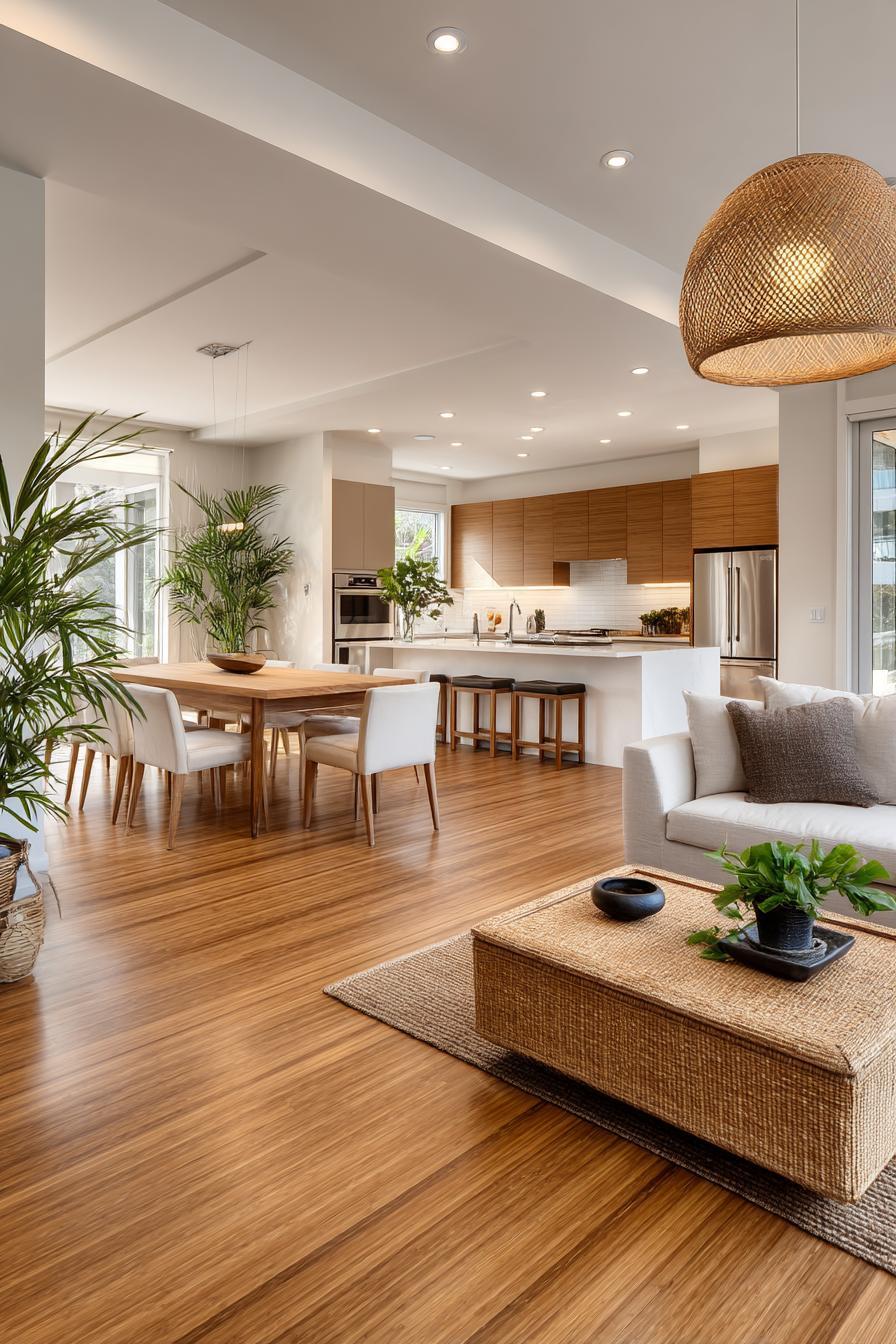
Bamboo flooring has gained popularity as an eco-conscious alternative to traditional hardwood due to its fast-growing nature and renewable harvesting. Technically a grass, bamboo matures in just 3–5 years—significantly faster than hardwood trees—which makes it a more sustainable choice for environmentally-minded homeowners.
Modern bamboo flooring comes in various styles, including vertical, horizontal, and strand-woven. Strand-woven bamboo, in particular, is known for its impressive durability and resistance to dents and wear, often outperforming some hardwood species in strength. It’s available in a wide range of finishes, from natural blond to carbonized amber tones and even darker stained hues.
Bamboo’s sleek grain and uniform texture lend themselves well to contemporary and minimalist interiors. It’s a low-maintenance material that holds up well in high-traffic areas and resists allergens—making it ideal for families and pet owners. With eco-certifications like FSC (Forest Stewardship Council) or GREENGUARD available, bamboo floors offer a responsible and stylish way to ground your space.
15. Cork Flooring
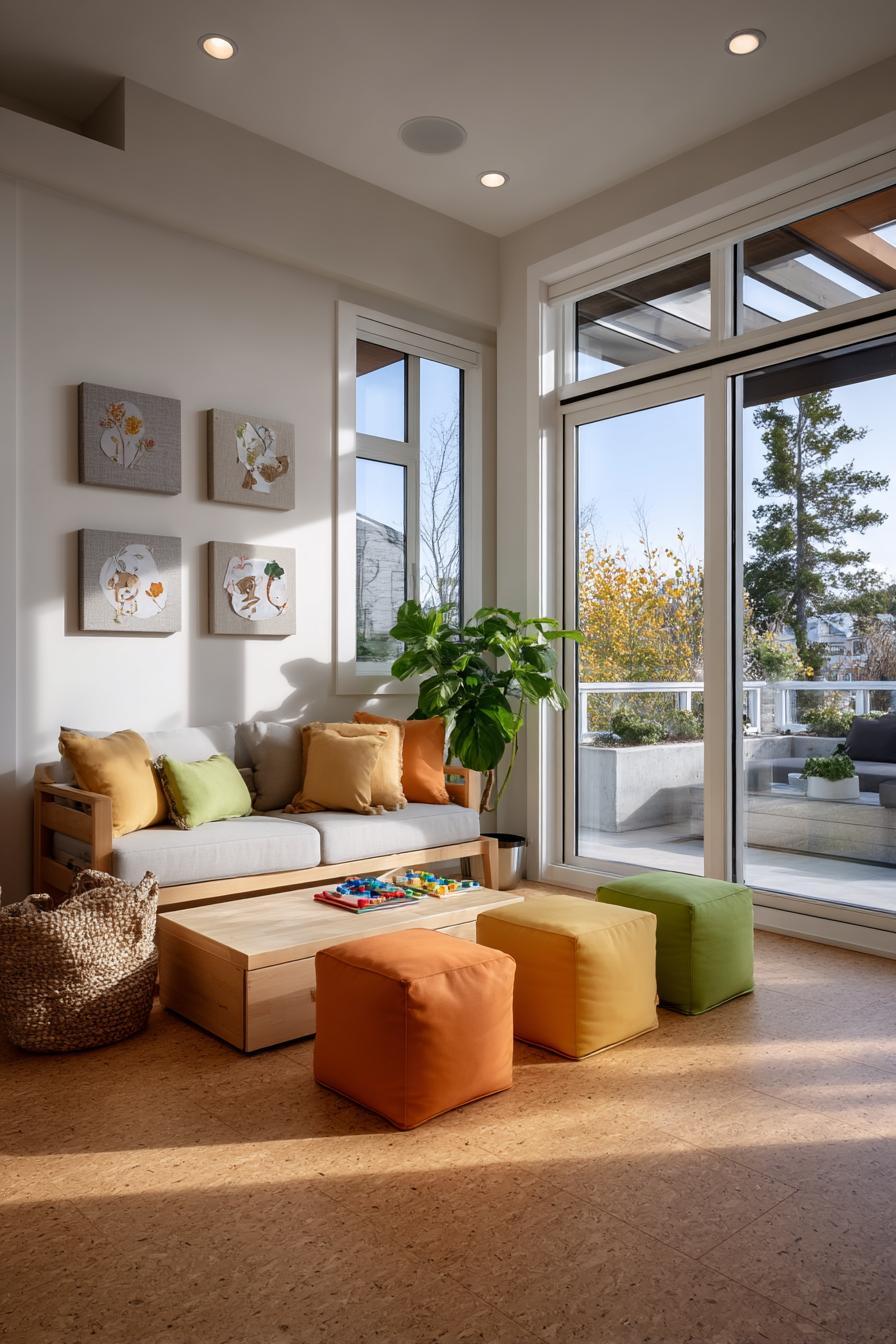
Cork flooring is a soft, quiet, and sustainable material harvested from the bark of cork oak trees—a process that doesn’t harm the tree, allowing it to regenerate naturally every 9–12 years. This renewable quality makes cork an excellent choice for eco-friendly interiors that prioritize both comfort and environmental stewardship.
Cork has a unique cellular structure that makes it naturally cushioned, thermal insulating, and sound-absorbing—ideal for bedrooms, playrooms, or home offices. It also resists mold, mildew, and insects, and is inherently antimicrobial, making it a smart option for allergy-prone households.
Modern cork floors come in a variety of colors, patterns, and tile sizes, many of which mimic the look of hardwood or stone. While cork is softer than hardwood and may dent under heavy furniture, its resilient surface recovers over time and can be protected with proper sealants. With its warm, organic appearance and eco-friendly appeal, cork is both a comfortable and conscientious flooring solution.
16. FSC-Certified Hardwoods
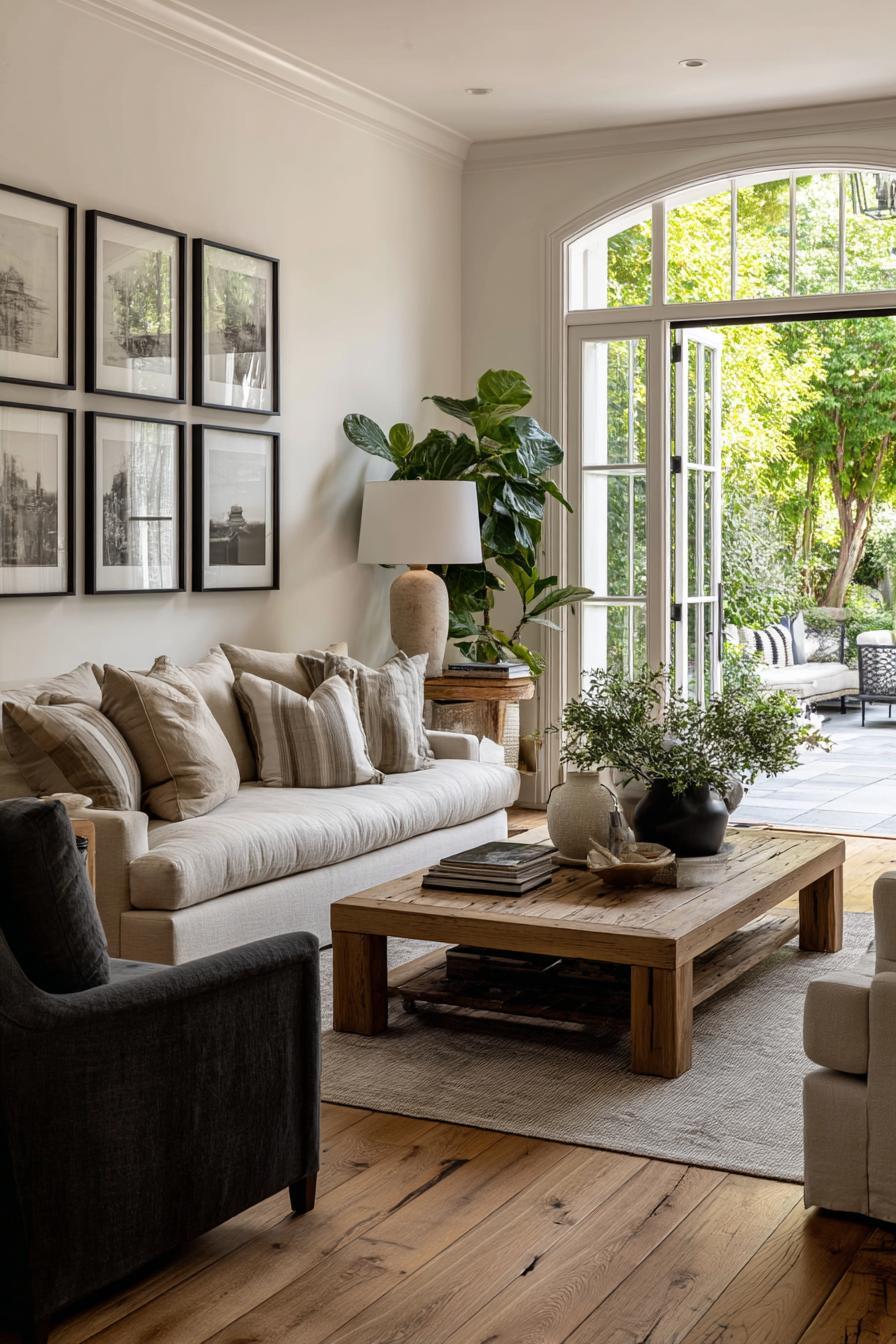
For those who want the look and feel of traditional hardwood but with environmentally responsible sourcing, FSC-certified hardwoods are the gold standard. The Forest Stewardship Council (FSC) certifies that wood comes from forests managed to strict environmental, social, and economic standards. This includes protecting biodiversity, preventing illegal logging, and supporting local communities.
FSC-certified flooring is available in nearly every wood species, including oak, maple, cherry, and walnut. It offers the same beauty and durability as conventional hardwood but with the added peace of mind that it was harvested sustainably. Many manufacturers also use non-toxic adhesives and low-VOC (volatile organic compounds) finishes to enhance indoor air quality.
This option is ideal for homeowners who want a luxurious, lasting wood floor while minimizing their ecological impact. Whether you’re building a green-certified home or simply making more sustainable choices, FSC-certified hardwoods deliver timeless style without compromise.
Technological Advancements in Wood Flooring
As innovation continues to influence home design, wood flooring has evolved beyond traditional materials and methods. Technological advancements now offer enhanced durability, easier installation, and even smart features that improve both the aesthetic and functionality of floors. These innovations are reshaping how homeowners think about and interact with wood flooring—from installation to everyday living.
17. Engineered Wood Innovations
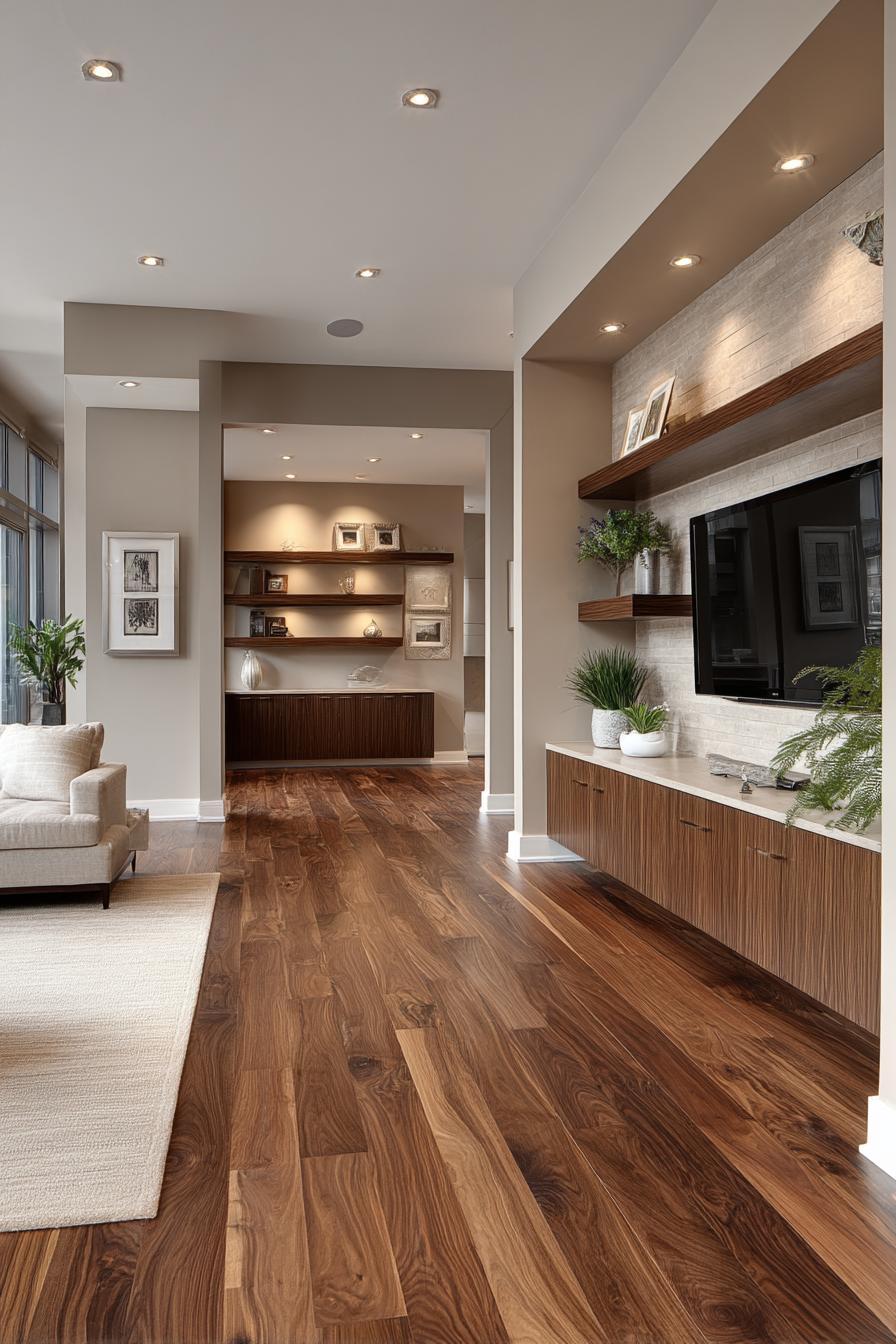
Engineered wood flooring represents one of the most significant advancements in modern flooring. Unlike solid hardwood, engineered wood is composed of a real wood veneer atop a core made of plywood or high-density fiberboard (HDF). This layered construction increases dimensional stability, making engineered wood more resistant to moisture and temperature fluctuations—a key advantage in basements, kitchens, and areas with underfloor heating.
Today’s engineered wood comes in a wide range of styles, plank sizes, and finishes, including wire-brushed, distressed, and high-gloss options. Many products offer click-lock systems for floating installations, simplifying the process and making it accessible for DIYers.
Engineered flooring can be refinished (depending on veneer thickness), and its top layer is virtually indistinguishable from solid hardwood. It’s also more sustainable, using less precious hardwood and supporting responsible forest management. With durability, aesthetic variety, and environmental benefits, engineered wood is a smart, future-forward flooring choice.
18. Waterproof Wood Flooring
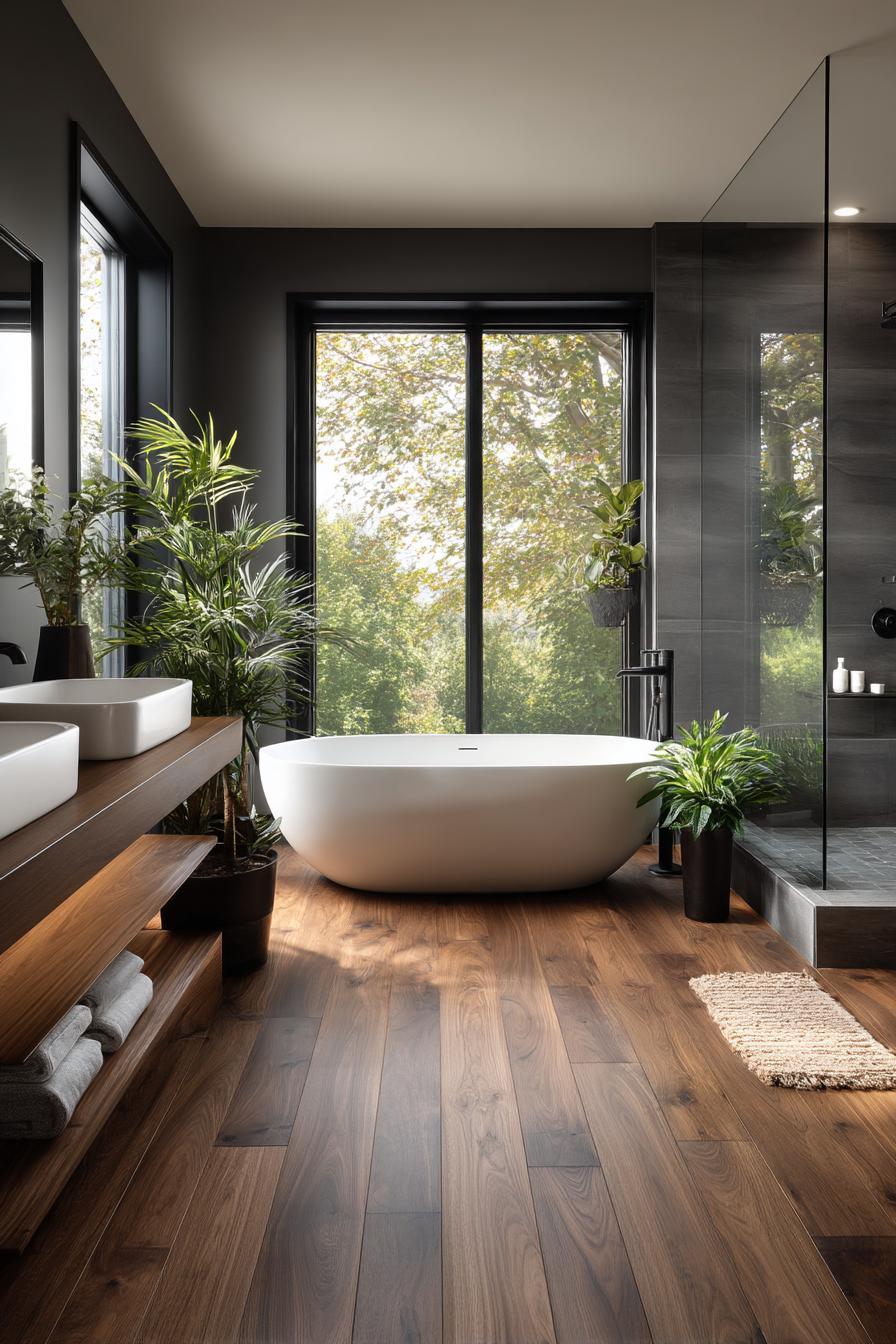
One of the most exciting developments in recent years is waterproof wood flooring—a solution that combines the natural beauty of wood with the functionality of water resistance. Ideal for kitchens, bathrooms, mudrooms, and even basements, these floors withstand moisture, spills, and humidity better than traditional hardwood.
There are two primary approaches: waterproof engineered hardwood, which features a special water-resistant core and sealed edges, and luxury vinyl planks (LVP) or rigid core flooring that convincingly mimic real wood. Brands have developed proprietary technologies to ensure these products are not only waterproof but also durable and comfortable underfoot.
Waterproof wood flooring is a game-changer for families, pet owners, and anyone seeking low-maintenance luxury. It allows for consistent flooring throughout the home, including areas previously deemed off-limits for wood, without sacrificing style or performance.
19. Smart Flooring Systems
Smart home technology has made its way underfoot with the emergence of smart flooring systems. These cutting-edge installations can include features such as integrated radiant heating, motion sensors, energy-efficient LED path lighting, and pressure-sensitive tiles that monitor foot traffic and security.
Get the Fail-Safe Paint Color Playbook (Free PDF)
36 proven colors • 8 ready palettes • trim & sheen guide • printable testing cards.
In particular, heated wood floors—often used in tandem with engineered planks—offer comfort during colder months and are more efficient than traditional forced-air systems. Meanwhile, sensor-enabled floors can provide safety alerts for seniors or automate lighting based on movement, enhancing both convenience and peace of mind.
While still an emerging market, smart flooring is ideal for tech-savvy homeowners seeking to future-proof their living spaces. Combined with beautiful wood surfaces, these systems seamlessly blend innovation with comfort and style.
20. Easy-Installation Systems
Gone are the days when installing wood flooring was a lengthy, professional-only process. Modern easy-installation systems—such as click-lock, tongue-and-groove, and adhesive-free planks—have transformed the installation experience, making it more accessible to DIY enthusiasts and faster for contractors. These systems allow for floating floors that require no nails or glue, significantly reducing both labor and mess.
Click-lock engineered wood is especially popular due to its precision-milled edges that snap together seamlessly, creating tight seams and stable surfaces. Many of these systems also feature pre-attached underlayment layers that offer noise reduction, insulation, and moisture protection—all built into the plank.
For homeowners, this means less downtime during renovations and more flexibility in updating flooring without the hassle. Easy-install floors also facilitate partial replacements and are ideal for renters or anyone looking to make stylish upgrades with minimal disruption. These systems democratize design, allowing more people to enjoy the look of wood without extensive installation demands.
Section 6: Personalized and Artistic Expressions
For homeowners seeking individuality and creative flair, wood flooring offers more than a backdrop—it can be a central design statement. Through custom stains, artisan techniques, and mixed materials, modern flooring opens the door to self-expression. Whether you’re designing a one-of-a-kind foyer, an eclectic living room, or a gallery-style loft, these artistic ideas can transform wood floors into truly personal masterpieces.
21. Custom Stain Colors
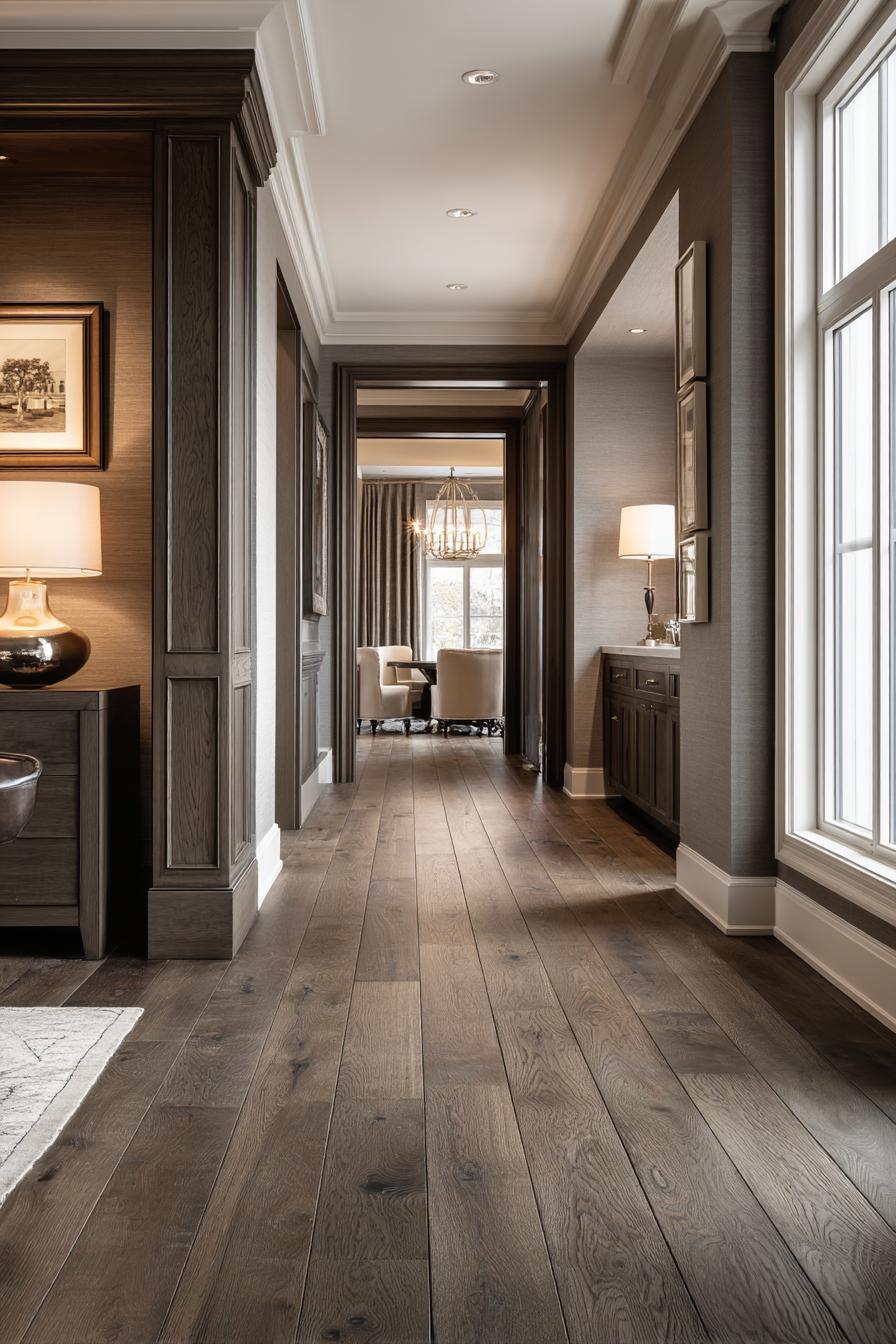
Custom stain colors allow homeowners and designers to tailor the exact hue and undertone of their wood floors to match a specific aesthetic or palette. From soft pink-tinted neutrals to rich espresso browns and smoky greys, the range of possibilities is virtually endless. This level of personalization ensures the floor harmonizes with furniture, cabinetry, and overall interior themes.
Custom staining can also bring out unique grain patterns or add depth to more affordable wood species, such as birch or pine, mimicking the look of more exotic hardwoods. Some even opt for layered staining—applying one color and then another to achieve a multidimensional effect.
This approach is particularly appealing in bespoke, high-end interiors or remodels where matching existing wood elements is critical. With professional application, a custom-stained floor becomes a defining element of the room—setting mood, enhancing light, and showcasing personality with every step.
22. Hand-Scraped Textures
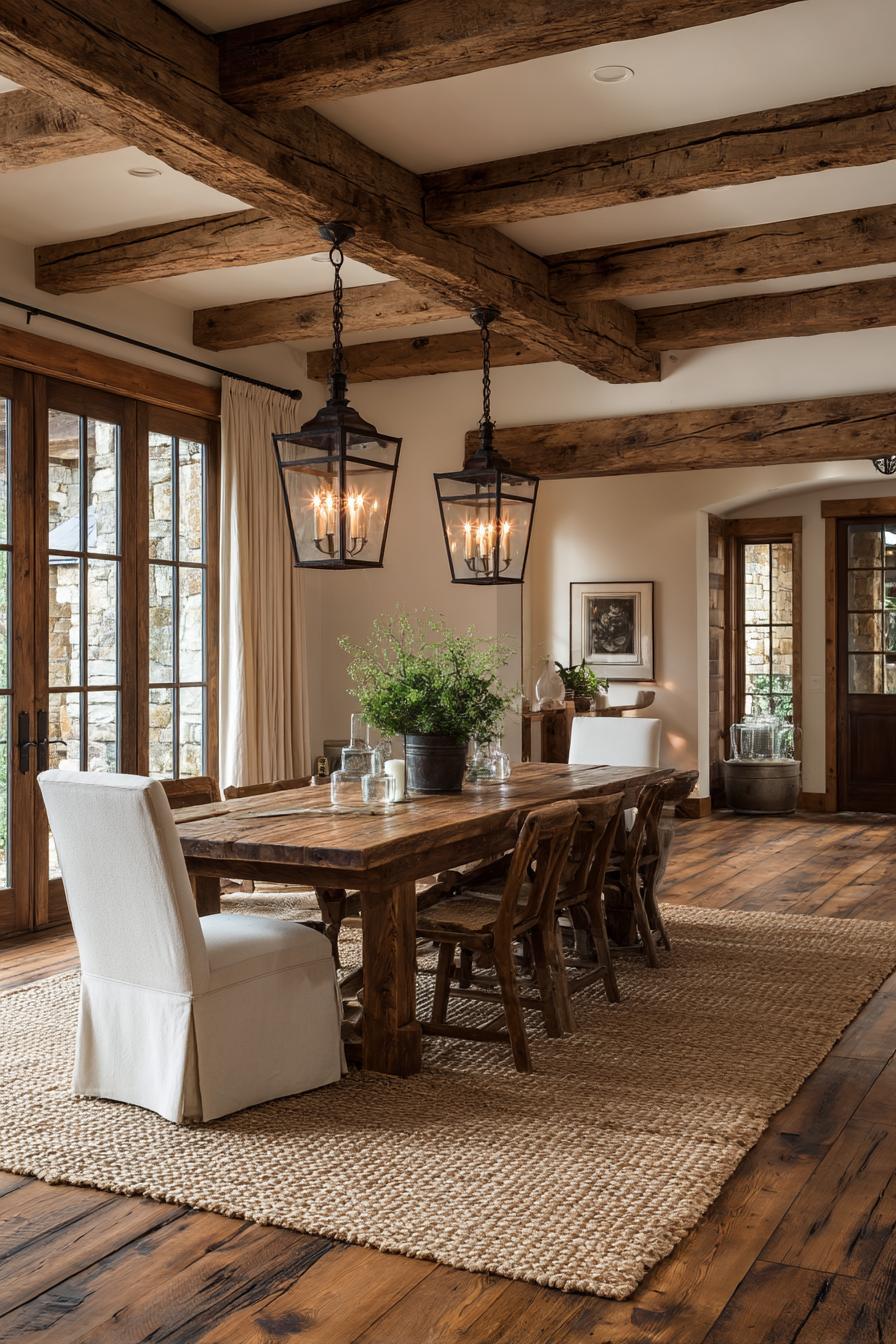
Hand-scraped wood flooring offers a rustic, artisanal touch that brings warmth, character, and a sense of craftsmanship to any space. Each plank is manually or machine-distressed to create subtle grooves and ridges that mimic the imperfections of antique, time-worn wood. The result is a tactile surface with unique variations in texture and depth, making every floor one-of-a-kind.
This finish is particularly well-suited for farmhouse, Tuscan, and traditional interiors, but can also provide a grounding element in eclectic or transitional styles. In addition to its aesthetic charm, hand-scraped floors are practical too—they’re excellent at concealing scratches, scuffs, and daily wear, making them ideal for high-traffic areas and family homes.
Hand-scraped textures are available in a variety of wood species and stain colors, from light oak to dark hickory, and pair beautifully with matte or oil-rubbed finishes. For those who crave authenticity and timeless charm, hand-scraped flooring is a rich and enduring option.
23. Mixed Material Inlays
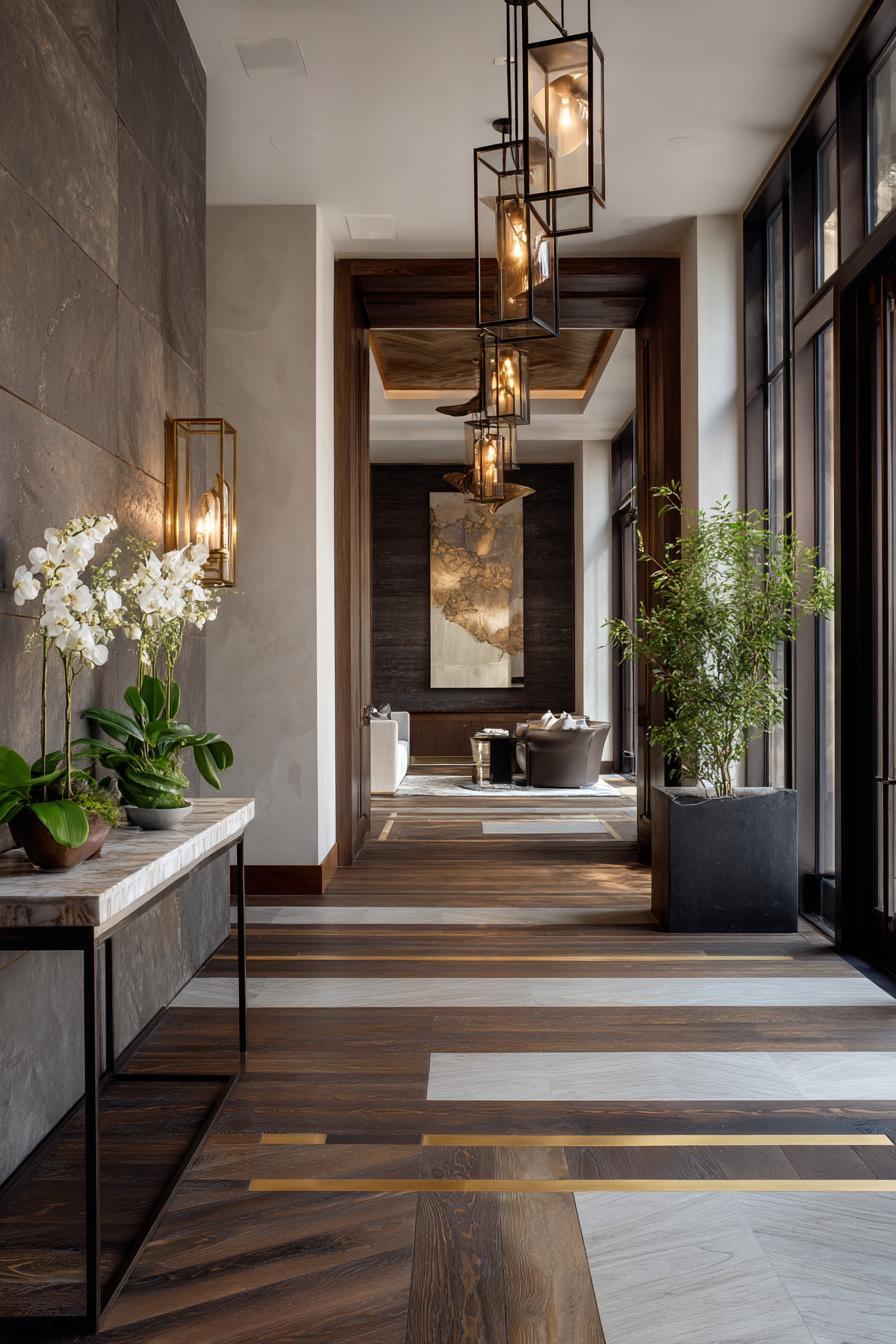
Incorporating mixed materials—like metal, stone, or glass—into wood flooring inlays allows for a completely custom look that blends textures and tones. These inlays are often used to highlight architectural features, define room boundaries, or simply add visual intrigue. Brass or copper strips, for example, can be inserted between planks to introduce a metallic glint, while marble or slate tiles can create mosaic-like floor medallions or borders.
This approach is ideal for entryways, foyers, dining rooms, or any space where a bit of drama or luxury is welcome. Mixed material inlays can be bold or subtle, depending on the scale, finish, and contrast used. They’re also excellent for drawing attention to symmetry or creating a focal point beneath lighting fixtures or furnishings.
Installing mixed inlays requires skilled craftsmanship and precise planning, but the end result is striking—a floor that not only supports the space but enhances it with unique artistry and tactile dimension.
24. Painted Wood Floors
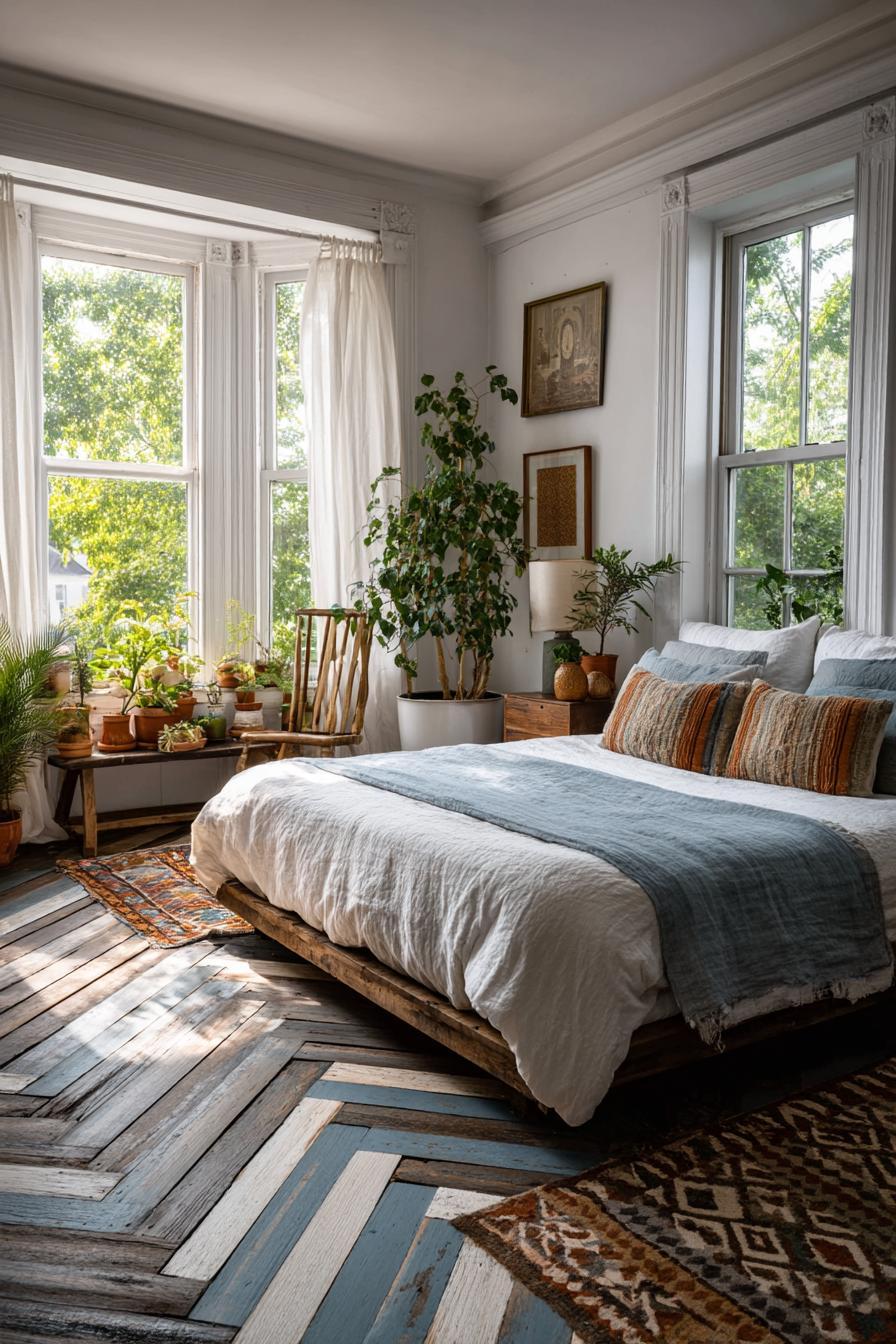
Painted wood floors offer a bold and creative way to transform traditional planks into a statement canvas. Whether using solid colors, stenciled patterns, or hand-painted motifs, this technique allows for endless personalization. It’s an especially appealing option in vintage, cottage, or artistic spaces where playfulness and individuality are celebrated.
White-painted floors can open up a small room, while black or navy can add depth and grounding. Geometric patterns like chevrons, checkerboards, or herringbone can mimic more expensive flooring designs at a fraction of the cost. Painted designs also allow for easy seasonal or stylistic updates—simply repaint to match a new aesthetic.
Ideal for older homes where wood floors may be structurally sound but visually dated, painting offers a budget-friendly makeover with high impact. While it requires proper surface prep and sealing for durability, a painted floor can become a vibrant, standout feature that reflects your personality from the ground up.
25. Epoxy Resin Accents
Epoxy resin flooring has become a popular choice for modern, industrial, and artistic interiors, and when paired with wood, it opens up a world of creative possibilities. This hybrid technique typically involves embedding wood pieces—such as live-edge planks or reclaimed slabs—within colored or clear epoxy resin to create one-of-a-kind surfaces with a glass-like finish.
Get the Fail-Safe Paint Color Playbook (Free PDF)
36 proven colors • 8 ready palettes • trim & sheen guide • printable testing cards.
Epoxy wood floors can range from subtle accents (like resin-filled cracks or knots in distressed wood) to full-blown artistic installations featuring rivers, metallic swirls, or embedded objects. The resin not only protects and preserves the wood but also adds depth and luminosity, making it appear as though the wood is floating within the floor.
Ideal for statement-making rooms such as modern living areas, home offices, or boutique-style commercial spaces, epoxy wood floors are durable, waterproof, and highly resistant to wear. While more complex to install, the visual payoff is stunning—blending organic material with futuristic style in a way that truly transforms the room.
Conclusion
Wood flooring is no longer just a foundational element—it’s a focal point of design, style, and self-expression. As we’ve explored, today’s wood floor trends span from timeless classics like herringbone and parquet to bold innovations like epoxy resin accents and smart technology integrations. Whether your aesthetic leans traditional or ultra-modern, there’s a wood flooring concept to match and elevate your space.
By combining layout creativity, advanced finishes, sustainable materials, and personalized touches, these 25 design ideas offer more than beauty—they create impact. Floors are one of the largest surfaces in your home; making thoughtful choices here enhances not only how your space looks, but how it feels and functions.
No matter your budget or style, let your floors tell your story. With the right idea, you can craft a space that’s grounded in style and rich with character—right from the ground up.
